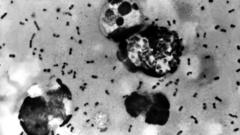Article Text:
Health officials in Arizona have confirmed that a local resident has died from pneumonic plague, a notable incident as it marks the first recorded death from this disease in Coconino County since 2007. According to the Coconino County Health and Human Services, previous cases often involved human interaction with infected animals.
Historically known as the "Black Death," plague was responsible for catastrophic loss of life in 14th-century Europe, but it's now a rare occurrence among humans, with an average of around seven reported cases annually in the United States, as stated by the Centers for Disease Control and Prevention (CDC).
Despite the severity of pneumonic plague, which is a grave lung infection caused by the bacterium Yersinia pestis, the Coconino County government has reassured the public that the risk of exposure remains low. "Our hearts go out to the family and friends of the deceased," Coconino County Board of Supervisors Chair Patrice Horstman expressed in a statement, adding that out of respect for the grieving family, no further information will be released regarding the individual.
Different forms of plague exist, with bubonic plague being the most prevalent, typically transmitted through flea bites. Pneumonic plague, which develops from untreated cases, is considered to be the most serious and is relatively uncommon. Symptoms of bubonic plague usually emerge within two to eight days following exposure and can include fever, chills, headaches, fatigue, and swollen lymph nodes.
The UK government reports that plague is no longer present in the country and that the likelihood of it appearing among returning travelers remains very low. Preventive measures recommended by health officials involve using insect repellents containing DEET, avoiding contact with dead animals or infected tissues, and steering clear of individuals displaying symptoms, particularly in areas where cases have been reported recently.
Health officials in Arizona have confirmed that a local resident has died from pneumonic plague, a notable incident as it marks the first recorded death from this disease in Coconino County since 2007. According to the Coconino County Health and Human Services, previous cases often involved human interaction with infected animals.
Historically known as the "Black Death," plague was responsible for catastrophic loss of life in 14th-century Europe, but it's now a rare occurrence among humans, with an average of around seven reported cases annually in the United States, as stated by the Centers for Disease Control and Prevention (CDC).
Despite the severity of pneumonic plague, which is a grave lung infection caused by the bacterium Yersinia pestis, the Coconino County government has reassured the public that the risk of exposure remains low. "Our hearts go out to the family and friends of the deceased," Coconino County Board of Supervisors Chair Patrice Horstman expressed in a statement, adding that out of respect for the grieving family, no further information will be released regarding the individual.
Different forms of plague exist, with bubonic plague being the most prevalent, typically transmitted through flea bites. Pneumonic plague, which develops from untreated cases, is considered to be the most serious and is relatively uncommon. Symptoms of bubonic plague usually emerge within two to eight days following exposure and can include fever, chills, headaches, fatigue, and swollen lymph nodes.
The UK government reports that plague is no longer present in the country and that the likelihood of it appearing among returning travelers remains very low. Preventive measures recommended by health officials involve using insect repellents containing DEET, avoiding contact with dead animals or infected tissues, and steering clear of individuals displaying symptoms, particularly in areas where cases have been reported recently.



















